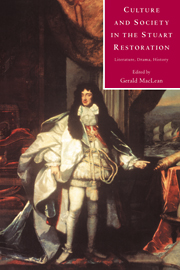Book contents
- Frontmatter
- Contents
- Notes on contributors
- Acknowledgments
- Abbreviations and note on the text
- INTRODUCTION
- PART I DRAMA AND POLITICS
- 2 The quest for consensus: the Lord Mayor's Day Shows in the 1670s
- 3 Politics and the Restoration masque: the case of Dido and Aeneas
- 4 Factionary politics: John Crowne's Henry VI
- PART II AUTHORSHIP AND AUTHORITY
- PART III WOMEN AND WRITING
- PART IV EMPIRE AND AFTERMATHS
- Index
2 - The quest for consensus: the Lord Mayor's Day Shows in the 1670s
Published online by Cambridge University Press: 20 August 2009
- Frontmatter
- Contents
- Notes on contributors
- Acknowledgments
- Abbreviations and note on the text
- INTRODUCTION
- PART I DRAMA AND POLITICS
- 2 The quest for consensus: the Lord Mayor's Day Shows in the 1670s
- 3 Politics and the Restoration masque: the case of Dido and Aeneas
- 4 Factionary politics: John Crowne's Henry VI
- PART II AUTHORSHIP AND AUTHORITY
- PART III WOMEN AND WRITING
- PART IV EMPIRE AND AFTERMATHS
- Index
Summary
Civic pageantry had enjoyed a long and distinguished career throughout Europe by 1660. The tradition of street pageantry was an old one, incorporating emblematic imagery, both verbal and visual, with a long ancestry of political service. It had proved an effective means for cities, magnates, guilds, and mayors to demonstrate their wealth and influence. In England, civic spectacles had such an immense popularity among Londoners that James I had relied on the drawing power of the Lord Mayor's Day Show to rob his nemesis Sir Walter Raleigh of the constituency for his final performance. Raleigh had asked for a delay of a few days to prepare for his execution, “but was refused, and it was determined to carry out the execution on the following morning, 29 October 1618. That was the day of the Lord Mayor's Pageant, which would be sure to draw a large crowd to the east end of London, and thus, it was hoped, deprive the actor of an audience.” The popularity of these entertainments may have had as much to do with the free handouts provided by the various guilds as it did with the spectacles and themes of the pageant. However, beyond this possibility for free advertising and the occasion to parade the guilds' immense wealth, there were ideological overtones as well. Indeed, once Charles II began attending the Lord Mayor's Show regularly after 1671, these pageants began to promote government propaganda directly.
- Type
- Chapter
- Information
- Culture and Society in the Stuart RestorationLiterature, Drama, History, pp. 31 - 51Publisher: Cambridge University PressPrint publication year: 1995
- 3
- Cited by

